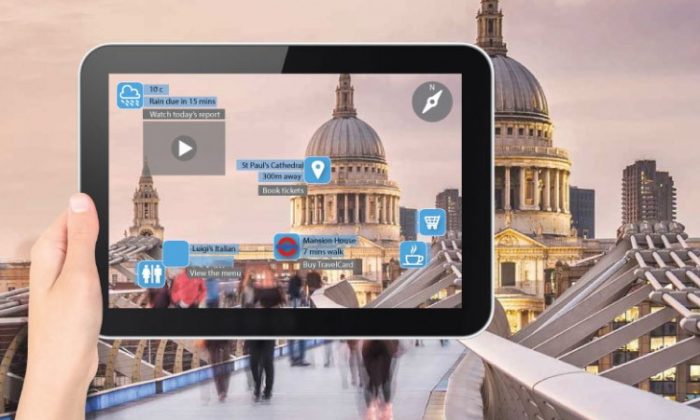Introduction
From Darwin’s theory of us being apes to the technological leap we are taking every year leaves perplexed any man.
Two topics of such nature will make you realize our futuristic streak: Augmented Reality and Virtual Reality. Let’s explore.
It all started in the 1990’s when virtual reality was a fad after several companies gave their best shots but failed. Devices like Nintendo Virtual Boy were also experimented with the notion but to no avail. However, Virtual reality is lurking around the corner again.
So, what’s Virtual reality then? It must be related to this AR too right?
Well, It is an interactive reality made with the help of a software. One
would feel the surroundings as real, but in effect they are imaginary.
VR helmets or goggles give this euphoria to their users, 3d glasses
can also be classified underneath VR. The transformers 3D tour in
Hollywood studios at Los Angeles uses such VR, making you feel you
have travelled the whole galaxy and jumped from a 100 feet building
when I reality, you are just in a cart wearing glasses. LOLZ.
Augmented Reality
Virtual Reality
Augmented reality on the other hand is a complete different when put in contrast to Virtual
reality. It has gained more consumer acceptance than its predecessor. Video games,
Google glass and such applications are utilizing AR (sounds like the IRobot technology
right?). AR is the market leader nowadays, and seems like it will continue its monarchy for
quite a time. Now, you may be thinking What the heck is this AR?
Well, it is like a smoothie of virtual reality and real life. Images are created within
applications which act like the double exposure feature. These features mix with the
notions of the real world. Users can easily spot out the characteristics of the image(AR)
and the real world implications done to it.
Facebook’s Oculus Rift headset used VR in two ways:
Mounting the VR with fantasy for gaming, entertainment, and streaming of online of 3D content. (Cinemas are an excellent example for streaming 3D movies).
Giving stimulations to professionals by creating different situations and how to cope with them. There are also some apps which provide stimulations like Airplane stimulator or Goat stimulator, you do need to buy the VR glasses and make sure the application provides 3D stimulation.
A coding language called VRML (Virtual Reality Modeling Language( is used to create VR. It has a series of images and the describes the possible interactions for the images.
AR is the trend. From score widgets you see on your screens while streaming a super bowl or any sport to 3D emails, photos and even text messages use this technology. Pioneers of this industry are achieving eye popping results with AR, holograms and motion activated commands are some of their examples. Google Now, Siri can also be interpreted as AR’s.
Augmented Reality
Ever used Adobe Photoshop? Know of the layers feature it comes with? Well, AR uses the same concept. It has a layer of system enhancements, which are applied on the existing reality. This makes the real image an intuitive interaction. Applications and mobile devices use AR engulfing the digital world into the real world, giving it a more detailed aspect. If needed, it can be separated as well.
Technology
Both give user a qualitative excursion. The come from the same roots of the technology delivering varieties of results.
Entertainment
Both technologies facilitate the entertainment sector. They may have seemed as a crack head notion in the past, they have opened portals to imagine anything and make it happen or renovate a daily life situation into something productive. Tech gurus know the intensity and value of these both realities. They are investing research and adopting their products into their applications, refining their applications. This helps them increase their market growth as consumers love new features and updates to the boring interfaces.
Science and Medicine
Both have capability in empowering the field of medicine. They have already been implemented to treat Post Traumatic Stress Disorder (PTSD). Efforts are being made to perform surgeries remotely with their aid.
Similarity
Differences
Purpose
AR adds senses, graphics and digital images on the real-world interaction. Virtual creates what the user wants to create.
Delivery Method
VR are delivered through head mounted or a hand-held controller. Navigation in that world is controlled by the user and where he/she wants to explore. Basically, a stimulation.
AR’s use is frequent in laptops, cell phones, and tablets showing or displaying what is connected to the reality.
Coordination between the two
AR and VR are not always the rivals; they work along sometimes too. Their fusion can create more enhancements. Haptic feedback is one such case where the vibration and the sensation are loaded with the graphics. This process is called augmentation. Virtual reality and augmented reality are great examples of experiences and interactions fueled by the desire to become immersed in a simulated land for entertainment and play, or to add a new dimension of interaction between digital devices and the real world. It does not matter if they are segregated or copulated, they create portals of futuristic potential for the normal user.
As stated above, AR is the monarch. It is being used in the market, with
increases in the hardware (AR), such as Glass from the acclaimed
Google. Ancestral companies like Microsoft are showing their interest
in this field of investment too.
VR, on the other hand is a appetizer. However, it is progressing
gradually to the summit with the likes of Oculus Rift.
Both AR and VR seem on track. Commercial market is the hub for AR,
as it does not create that fantasy feeling. While VR will seem a good fit
for gaming consoles, movies, or may even be a considerable option in
the field of education. Just imagine, wearing VR goggles in the
classrooms and seeing the formula of quadratic equation trying to
penetrate in your brain.







Read 0 comments and reply